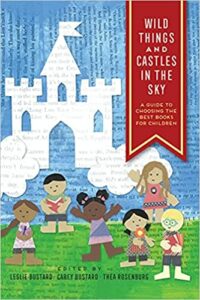 One of the books I praised most heartily earlier this year was Wild Things and Castles in the Sky: A Guide to Choosing the Best Books for Children edited by Leslie Bustard, Carey Bustard, and Thea Rosenburg (Square Halo Books; $29.99 – OUR BOOKNOTES DISCOUNT PRICE = $23.99.) It is one of my favorite books about books and certainly on the top of the list of books parents should have to inspire them to read widely to their kiddos. I like these kinds of books and whenever the opportunity presents itself, we recommend The Read Aloud Handbook by Jim Trelease (Penguin; $20.00) and the lovely, updated Honey for a Child’s Heart: The Imaginative Use of Books in Family Life by Gladys Hunt (Zondervan; $21.99)
One of the books I praised most heartily earlier this year was Wild Things and Castles in the Sky: A Guide to Choosing the Best Books for Children edited by Leslie Bustard, Carey Bustard, and Thea Rosenburg (Square Halo Books; $29.99 – OUR BOOKNOTES DISCOUNT PRICE = $23.99.) It is one of my favorite books about books and certainly on the top of the list of books parents should have to inspire them to read widely to their kiddos. I like these kinds of books and whenever the opportunity presents itself, we recommend The Read Aloud Handbook by Jim Trelease (Penguin; $20.00) and the lovely, updated Honey for a Child’s Heart: The Imaginative Use of Books in Family Life by Gladys Hunt (Zondervan; $21.99)
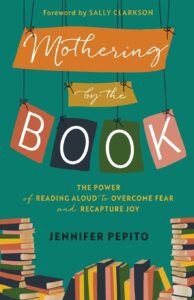
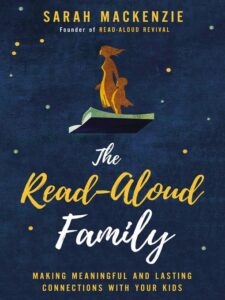 Recently we’ve gotten into the store the terrific book called Mothering By the Book: The Power of Reading Aloud to Overcome Fear and Recapture Joy by Jennifer Pepito (Bethany House; $16.99) that comes with a lovely foreword by the great Sally Clarkson. We shouldn’t forget the wonderful work of Sarah Mackenzie (founder of “Read Aloud Revival”) and her book The Read Aloud Family: Making Meaningful and Lasting Connections with Your Kids (Zondervan; $18.99.)
Recently we’ve gotten into the store the terrific book called Mothering By the Book: The Power of Reading Aloud to Overcome Fear and Recapture Joy by Jennifer Pepito (Bethany House; $16.99) that comes with a lovely foreword by the great Sally Clarkson. We shouldn’t forget the wonderful work of Sarah Mackenzie (founder of “Read Aloud Revival”) and her book The Read Aloud Family: Making Meaningful and Lasting Connections with Your Kids (Zondervan; $18.99.)
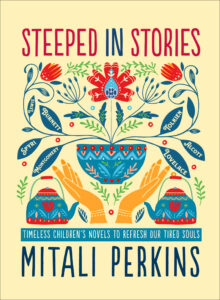
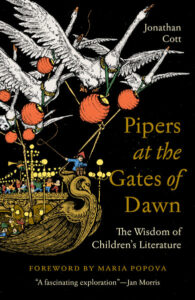 I like more reflective books on kid’s books as well. I can’t say enough about the stunning Steeped in Stories: Timeless Children’s Novels to Refresh Our Tired Souls by Mitali Perkins (Broadleaf; $24.99.) You really should read it! Recently, I’ve been dipping in to my old copies of the marvelous Wild Things: The Joy of Reading Children’s Literature as an Adult by Bruce Handy (Simon & Schuster; $17.00) and the somewhat eccentric and deep Pipers at the Gates of Dawn: The Wisdom of Children’s Literature by Jonathan Cott (University of Minnesota Press; $19.95.) There is in the new edition a forward by the ever brilliant (and perfectly suited for this nearly mysterious project) Maria Popova, founder of the weekly email newsletter, The Marginalian. As Jerry Griswold wrote about it in the Los Angeles Times Book Review,
I like more reflective books on kid’s books as well. I can’t say enough about the stunning Steeped in Stories: Timeless Children’s Novels to Refresh Our Tired Souls by Mitali Perkins (Broadleaf; $24.99.) You really should read it! Recently, I’ve been dipping in to my old copies of the marvelous Wild Things: The Joy of Reading Children’s Literature as an Adult by Bruce Handy (Simon & Schuster; $17.00) and the somewhat eccentric and deep Pipers at the Gates of Dawn: The Wisdom of Children’s Literature by Jonathan Cott (University of Minnesota Press; $19.95.) There is in the new edition a forward by the ever brilliant (and perfectly suited for this nearly mysterious project) Maria Popova, founder of the weekly email newsletter, The Marginalian. As Jerry Griswold wrote about it in the Los Angeles Times Book Review,
“This book is a serious, even profound study of complex writers and the depth concealed under the hard-wrought simplicity of their stories.”
 Perhaps that is what some of the myriad authors in Wild Things and Castles in the Sky are getting at, which is why I loved it so. There is so much going on in “hard-wrought” simple stories that end up being not so simple after all. Co-editor of Wild Things, educator Carey Bustard, offers her kid’s lit reviews in her chapter framed by notions of goodness, beauty, and truth. Artist and songwriter Matthew Clark’s piece mentions fantasy novelist George MacDonald and how he “gently scratches the surface to release the delicious fragrance of goodness.” Joy Strawbridge’s entry on Middle Grade Fiction is called “Growing Holy Imagination.” That’s it, isn’t it?!
Perhaps that is what some of the myriad authors in Wild Things and Castles in the Sky are getting at, which is why I loved it so. There is so much going on in “hard-wrought” simple stories that end up being not so simple after all. Co-editor of Wild Things, educator Carey Bustard, offers her kid’s lit reviews in her chapter framed by notions of goodness, beauty, and truth. Artist and songwriter Matthew Clark’s piece mentions fantasy novelist George MacDonald and how he “gently scratches the surface to release the delicious fragrance of goodness.” Joy Strawbridge’s entry on Middle Grade Fiction is called “Growing Holy Imagination.” That’s it, isn’t it?!
In a chapter on suffering called “Cracks in the Creation”, Ashley Artavia Novalis writes wisely about various sorts of kid’s books that approach this tender topic with great empathy. Recalling a memorable Mister Rogers’ episode about the assassination of Robert F Kennedy she tells how Mister Rogers offered “a masterclass in how families can help children grieve and serves as a prime example of one of Mister Rogers’ key philosophies behind the neighborhood: “Anything that’s human is mentionable, and anything that is mentionable can be more manageable.””
“In the same way,” Novalis continues, “good stories of adversity provide a language for suffering.”
Which brings me to…
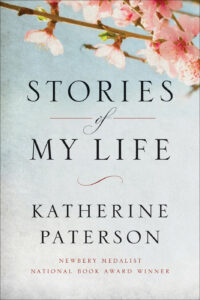
Stories of My Life Katherine Paterson (Westminster John Knox) $22.00 OUR BOOKNOTES 20% OFF SALE PRICE = $17.60
Which brings me to one of the great patron saints of 20th century (and early 21st century) children’s literature, the extraordinary Katherine Paterson. Had I been asked to do a chapter in a book like Wild Things and Castles in the Sky I’d have surely told of my own learning to love children’s books as an adult while reading (or listening to) Bridge to Terabithia, The Great Gilly Hopkins, and Jacob Have I Loved, three of the most esteemed and honored of Paterson’s dozens of books. I will never forget the spectacular talk she gave at the 1998 Calvin College Festival of Faith and Writing on the role of the imagination, the best of the keynotes that year, sandwiched between Elie Weisel and John Updike. She tells about that lecture, and staying in the Grand Rapids home of the legendary writer (and Calvin prof) Gary Schmidt for that weekend, when she got the phone call saying she won the prestigious Hans Christian Andersen Award, in her new book of memories, Stories of My Life. It is utterly magnificent, touching, and I found it captivating — a gentle but absolute page-turner!
I was very moved by this sprawling set of memories from her life, including what she has learned about parents and grandparents on her side of the family — she was a Womeldorf; her mother came from a grand Southern family, the Goetchius’s. We learn a bit about the colorful stories of her late husband — he was a Paterson (“with one t” she noticed, quickly) whose own father had very colorful years of, among other things, serving in World War One, being gassed, losing a leg, and being treated for TB. It is very nicely written with a calm and no-nonsense style. It was truly lovely, without being luminous, engaging without pretension. She says firmly in the beginning that it is not a memoir. It is, as the title sensibly proclaims, a set of stories from her life.
And what a life she has led. I can hardly say enough about this wonderful read about a wonderful Christian woman whose contribution to (and fame in) the world of contemporary children’s literature is nearly unsurmountable. She is, certainly, one of the great children’s writers of these times.
How can I persuade you to order this handsome volume full of entertaining and edifying stories of a life well lived? If you do not know that she was born in China (her parents were medical missionaries) who fled as a little one during the Japanese invasion, and who returned, only to be exiled again (mostly due to tensions with the communists that time) and you do not know that she herself was a Presbyterian missionary in Japan, if you do not know her moving stories like Bridge to Terabithia and her several nonfiction books about the role of the imagination and of faithful but not overtly religious storytelling, I hardly know where to begin. Any good library would have her many out of print children’s titles and now you can easily learn about her life and times.
Here are just a few fascinating and enjoyable moments you will encounter if you order Stories From My Life.
Firstly, you know you are in for a treat (and will be walking among the gods of stories) when you open the book to find a fabulous short intro by none other than Kate DiCamillo. She highlights a key moment of vulnerability in the narrative when she alerts us to Katherine’s story of being a child (home from the Chinese mission field, wearing second-hand clothing, a bit shy, and seemingly not welcomed into her new school) and not receiving any Valentine Day cards in school. Kate notes that Katherine writes that she told her mother many years later about this and she was, of course, aghast. Mother wondered why Katherine never wrote about the hurtful incident. As DiCamillo recalls, Katherine “answered her by saying, “All my books are about the day I didn’t get any valentines.”
And then, in her own great gift, the great Kate DiCamillo says:
This book is a valentine.
It is Katherine’s Valentine to her parents and to her children. It is her Valentine to life and to stories.
It is her valentine to us.
Kate Dicamillo also has badgered Katherine to include the story of Maude, a relative of her grandfather’s who was the last person to kiss Robert E. Lee, who, in turn kissed little Katherine. DiCamillo loved the story so, she threatened to write it up herself if Katherine didn’t write it down. So, yes, here is the bit about Lee, although, personally, I enjoyed the episode about her brother and the bones of Lee’s famous horse, Traveller. You will have to read it to discover that yourself.
The second foreword is so endearing and masterfully written and insightful that I’ve read it twice — it is by writer Nancy Price Graff and she tells of the twosome’s weekly lunch at a diner in their town in Vermont. For over twenty years the women have grown old together in their regular Naugahyde booth. Paterson has written 40-some books in fifty years, performing what she calls “the fragile magic” of spinning stores for children and young adults. But she doesn’t talk about her writing or much about her fame.
“Week after week,” Graff writes,
…one of the great storytellers in the world has told me the story of her exceptional life. Diners no more than three feet away, deep into their meatloaf, are oblivious to the presence of the former National Ambassador for Young People’s Literature, the winner of the Astrid Lindgren Memorial Award, and the Hans Christian Andersen Award. It would never cross their minds that the gray-haired woman sitting two booths over, wearing a turtleneck and a pink sweater, might have had dinner last week with the librarian of Congress or the empress of Japan.
The stories are not exactly chronological and in fact, starts with a good piece responding to “Three Frequently Asked Questions.” I was hooked. In one of these early pages she tells of being at the Presbyterian School of Christian Education in Richmond, Virginia. (Now known as Union, it was started when there was a need for theological education for women headed to the mission field or into educational tasks since the Presbyterian churches were not yet ordaining women so women were not as likely to attend a seminary like Princeton, say.) One of her favorite professors stopped her in the hall — he has been reading her exam —and said in made her wonder if she ever thought of being a writer.
Now I, the lifelong reader, the summa cum laude graduate in English literature, knew what great writing was, so how could Dr. Little imagine, on the basis of an essay on an exam, that I could be a writer? ‘No,’ I said primly. I had no intention of being a writer because I wouldn’t want to add another mediocre writer to the world.
Well, the prof pushed back, wondering if perhaps that was exactly what God was calling her to do. Katherine tell us simply:
It was hard to imagine that God needed a lot more mediocre writers in the world, so I didn’t become a writer or movie star. I became a missionary.
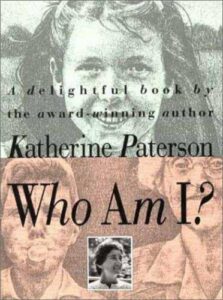 Her first piece of writing, by the way, was a great Sunday school book for middle school age kids published in 1966, Who Am I?, which is still in print from Eerdmans. She was by then home from her Japanese mission experience (1957 – 1961), had married John whom she had met at Union Theological Seminary in New York, and was teaching in Pennington NJ, while John attended Princeton. By ’66 they had moved to Tacoma Park, MD.
Her first piece of writing, by the way, was a great Sunday school book for middle school age kids published in 1966, Who Am I?, which is still in print from Eerdmans. She was by then home from her Japanese mission experience (1957 – 1961), had married John whom she had met at Union Theological Seminary in New York, and was teaching in Pennington NJ, while John attended Princeton. By ’66 they had moved to Tacoma Park, MD.
One of the opening questions in that long opening chapter was “How does it feel to be famous?” Children and others ask this at book readings and interviews and it is a question she is not fully comfortable with. She tends to be shy, although has learned to be brave. She tells of being at very fancy dinners at a head table and being ignored. She has been shunted here and there on book tours and speaking engagements and sometimes mistreated. She reports that she’d come home whining to her husband that she is not treated “like a human being.” This reveals both her insecurities, it seems, and her life’s overarching principle — that people, made in God’s image, should be treated with understanding and kindness. This matter of being uncared for comes up over and over and I found it quite gripping. Near the end of Stories… she admits that she wrote 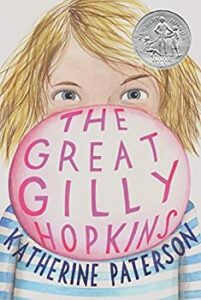 The Great Gilly Hopkins after pondering a question of how it would feel to be considered disposable.
The Great Gilly Hopkins after pondering a question of how it would feel to be considered disposable.
The Paterson’s have adopted two children, one from Hong Kong and one an indigenous Native baby. She and her husband were great parents, it seems. They have been foster parents, too, and it was painfully difficult. “After The Great Gilly Hopkins was published, I realized, belatedly, that I had put two foster children in the story. I might not have been Gilly. I might well have been William Ernest.”
She was an honorable child, usually, it seems, but playful and adventurous (and a good reader, bored with early school book readers.) There are stories of family in China, and of being back in the US, a “home” she did not know, of course. (Today we call this phenomenon being “third culture kids.”) Her parents loved her dearly, even though there were harrowing times of her dad being on Chinese riverboats trying to smuggle life-saving medicines and supplies to Christian hospitals for the Chinese people. There were times when he’d to travel undetected for remarkable distances, keeping away from the Japanese invaders and the young communists and certain military officials. What a story!
(Her parent’s backgrounds were fascinating themselves. She is somehow distantly related to Mark Twain. After WW I her father was cared for by a Mrs. Lathrop Brown, whose husband was a special assistant to the Department of Interior, high up in the Wilson administration. She had been a New York debutante and her husband had been Franklin Roosevelt’s roommate at Harvard. As a disabled veteran, he was fortunate to have her as a caregiver and she stayed in touch with her parents until she died. In fact, she sent boxes of children’s books to little Katherine in China. When they were exiled from China and spent an awful time in 1938 as refugees, she had arranged for a chauffeur to meet them at the boat in New York harbor.)
Katherine’s time in Japan is explained and there are a few memorable stories. It doesn’t take much —she’s working that ‘fragile magic’ — and I was in tears at a going away party which had a Japanese pastor reading Ephesians 2:14 (a personal favorite, about the dividing walls being broken down in Christ) and Paul’s revolutionary words in Galatians 3:28. It is especially powerful knowing that Katherine had admitted that she had trained to return to her native China. Going there on mission was not to be and when she was assigned to Japan — the feared and despised enemy that had attacked China (and perpetrated atrocities such as the Rape of Nanking in 1937) — it caused turmoil in her soul. Of course she went and then, knowing the language and caring for the people, a Japanese pastor says,
Katherine is young, I am old. She is a woman, I am a man. She is American. I am Japanese. When she was the child of missionaries in China, I was a colonel in the occupying army in Manchuria. She comes from the Presbyterian tradition, I come from the Pentecostal. The world would think it is impossible that she and I should love each other. But Christ has broken down the barriers that should divide us. We are one in Christ Jesus.
After her own sermonizing just a bit, she notes how the influence of Japan is evident in all her work. “My first three novels are set there, as well as the beautiful picture book The Tale of the Mandarin Ducks, whose illustrations by Leo and Diane Dillard garnered a Boston-Globe-Horn Book Award.” She has translated some Japanese folk tales, as well, illustrated by the award-winning Suekichi Akab. She quietly notes that she wouldn’t be the writer she is if it were not for her four years in ministry there. “To be loved by people you thought hated you is an experience I wish everyone could have.”
“To be loved by people you thought hated you is an experience I wish everyone could have.”
She loved her job as a teacher, then, first in 1955 reading aloud to poor rural kids in a one-room school in Virginia. Oooh, was she irritated that these kids were all said to be dumb because they supposedly had done poorly on IQ tests. These kids were not dumb! (And she henceforth distrusted standardized tests.) She doesn’t think she was much of a teacher but she gave them good experiences (including a trip to the National Zoo in DC that, trust me, was a great episode to read about.)
What I lacked in pedagogical skill, I made up for by reading aloud — everything fromThe Lion, the Witch, and the Wardrobe and Huckleberry Finn to Shakespeare. Macbeth was a class favorite — all that gore. I’m sure I skipped and explained airway through several pages of the play, but they had a taste of greatness anyhow.
I choked back tears when she tells of going to visit the little school in Lovettsville years later while passing through the region. It was now a community center so she found the newer building. School had just closed but teachers were there, cleaning up as they do on their last day. Katherine marveled at the well-stocked library. Nobody had time, really, to chat until it became evident that she used to teach there and some old-timer had some recollections of people she had known decades beforehand they realized who she was. Oh, were they pleased, confident that Bridge to Terabithia’s Lark Creek was based on Lovettsville. The current sixth grade teacher said that he tells their students that each year and they never believe him. She assured him that he was right.
She also taught for a while in a Methodist boys school, teaching the Bible. There’s a great story there about a boy complaining about how all the kings of the Old Testament seemed to be getting killed and how irrelevant that all was. Before she could even answer, the classroom door was thrown open. “The history master was standing in the doorway, ashen faced. ‘The president has been shot,’ he said.”
She comments,
Without a word, we filed out into the common area where there was a large television set and watched in horror until Walter Cronkite finally announced the news that Kennedy was dead. The boys didn’t try to argue about the stupidity of the ancient Hebrew ever again.
This is a typical passage — casually reported yet full of pathos, poignant, even, and sort of sly. There are some fun laughs in the book —her young married life was hard and she had four young children (two of two different races) and yet she and her husband made do and did well. It’s a glorious part of the book, hearing about their married life and her efforts as a parent.
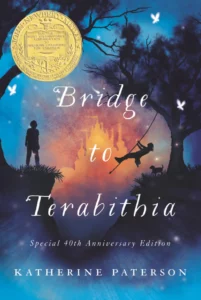 One of the most moving stories comes at about page 270 as she tells of her son, David, finally getting a good friend; Katherine had been diagnosed with cancer and worried about her children, but David, especially, needed a good pal. And then one day he met Lisa. Who — to cut a tender story short — was suddenly killed, struck by lightning at Bethany Beach. This was, of course, the genesis of the tragic story of a boy/girl friendship and the way youth cope with death that became Bridge to Terabithia. (You may recall that in that story they read The Chronicles of Narnia together.) She hardly wanted to finish writing the story and tells of putting off doing the chapter when Leslie Burke would die.
One of the most moving stories comes at about page 270 as she tells of her son, David, finally getting a good friend; Katherine had been diagnosed with cancer and worried about her children, but David, especially, needed a good pal. And then one day he met Lisa. Who — to cut a tender story short — was suddenly killed, struck by lightning at Bethany Beach. This was, of course, the genesis of the tragic story of a boy/girl friendship and the way youth cope with death that became Bridge to Terabithia. (You may recall that in that story they read The Chronicles of Narnia together.) She hardly wanted to finish writing the story and tells of putting off doing the chapter when Leslie Burke would die.
And to think Bridge to Terabithia has been maligned and banned! To think we have been criticized for carrying it!
It is fascinating how Katherine Paterson has often written about serious things. Her story of struggling with her first novel, The Sign of the Chrysanthemum, comes to mind. It is nicely told and she tells us much, but she offhandedly observes that she was doing a juvenile novel set in 12th century Japan (with a storyline of ancient civil strife, poverty, and which included trafficking and a brothel) at the same time that the nation’s number one best seller of adult fiction was a calming, almost silly narrative about a seagull named Jonathan. If you are a baby boomer, you know what she means.
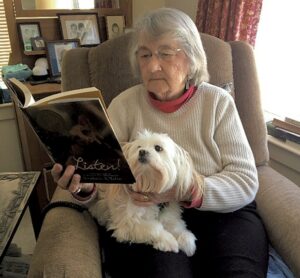 There are fun things to learn while reading Stories of My Life. She has a whole chapter called “Pets” and it involves more than their beloved dogs. Yes, the great Gilly Hopkins is named after Gerard Manley Hopkins. Jacob Have I Loved came out of thorny ground and a difficult time — her editor, the famous Virginia Buckley, had to push and pull to get her to develop it suitably. She missed the first Newbery Award press conference when a plane couldn’t land —Peter Spier was the only one who made it and he “single-handedly charmed the press and the American Library Association, melting the heart of blizzard-bound Chicago.” The story of what she allowed her kids to do with the first Newbery Award check —one thousand dollars was the prize amount and it was the most disposable income they ever had —is cute and made me chuckle. Her “self-effacing humor and extraordinary humility” (as the Publishers Weekly starred review put it) shines through over and over.
There are fun things to learn while reading Stories of My Life. She has a whole chapter called “Pets” and it involves more than their beloved dogs. Yes, the great Gilly Hopkins is named after Gerard Manley Hopkins. Jacob Have I Loved came out of thorny ground and a difficult time — her editor, the famous Virginia Buckley, had to push and pull to get her to develop it suitably. She missed the first Newbery Award press conference when a plane couldn’t land —Peter Spier was the only one who made it and he “single-handedly charmed the press and the American Library Association, melting the heart of blizzard-bound Chicago.” The story of what she allowed her kids to do with the first Newbery Award check —one thousand dollars was the prize amount and it was the most disposable income they ever had —is cute and made me chuckle. Her “self-effacing humor and extraordinary humility” (as the Publishers Weekly starred review put it) shines through over and over.
Early on Paterson notes that there were stories she heard growing up as the family did the dishes together. She wondered why many of these stories were not passed on to her own now grown children and grandchildren. You never told us that, they’d exclaim. (The answer is easy — they had a dishwashing machine which eroded such family time.) In a way, this book was written for her own loved ones. She set about finding diaries and letters and researched things in far away courthouses and museums to get more information behind the anecdotal stories she grew up with. She added much from her own life, her writing career, her travels around the world as an internationally known figure promoting children’s literacy and the imaginative arts.
We still have a copy of Gary Schmidt’s great 1994 biography — her Flip Flop Girl had just come out, I think — simply called Katherine Paterson. Now, in Stories of My Life we have her own amazing story, told in her own way and in her own voice.
I will not spoil the last two chapters but they are tender and touching. The very last is short but she ponders that one famous reviewer said, looking back over her work, said that she is a writer of hope. Indeed. But there is something behind that, she insists, and it is the Biblical doctrine of grace. She cites the words to the hymn Come Thou Font of Every Blessing. She is now 90, doing well, and active at the First Presbyterian Church in Barre, VT, where, as she puts it, she has “experienced the true communion of the saints.” It is a lovely ending to a marvelously entertaining book.

++++
TO PLACE AN ORDER
PLEASE READ AND THEN CLICK ON THE “ORDER HERE” LINK BELOW.
It is helpful if you tell us how you prefer us to ship your orders.
The weight and destination of your package varies
but you can use this as a general guide:
There are generally two kinds of US Mail options, and, of course, UPS. If necessary, we can do overnight and other expedited methods, too. Just ask.
- United States Postal Service has the option called “Media Mail” which is cheapest but can be slow. For one typical book, usually, it’s about $3.69; 2 lbs would be $4.36.
- United States Postal Service has another option called “Priority Mail” which is $8.35 if it fits in a flat rate envelope. Many children’s books and some Bibles are oversized so that might take the next size up which is $8.95. “Priority Mail” gets much more attention than does “Media Mail” and is often just a few days to anywhere in the US.
- UPS Ground is reliable but varies by weight and distance and may take longer than USPS. We’re happy to figure out your options for you once we know what you want.
If you just want to say “cheapest” that is fine. If you are eager and don’t want the slowest method, do say so. It really helps us serve you well.
– DON’T FORGET TO LET US KNOW WHAT SHIPPING METHOD YOU PREFER –
BookNotes
SPECIAL
DISCOUNT
20% OFF
ALL BOOKS MENTIONED
+++
order here
this takes you to the secure Hearts & Minds order form page
just tell us what you want to order
inquire here
if you have questions or need more information
just ask us what you want to know
Hearts & Minds 234 East Main Street Dallastown PA 17313
read@heartsandmindsbooks.com
717-246-3333
It is complicated for us, but we are still closed for in-store browsing due to our commitment to public health (and the safety of our family, staff,and customers.) The vaccination rate here in York County is sadly lower than average and the new variant is now spreading again; rates are rising Our store is a bit cramped without top-notch ventilation so we are trying to be wise.
Please, wherever you are, do your best to be sensitive to those who are most at risk. Many of our friends, neighbors, co-workers, congregants, and family members may need to be protected since more than half of Americans (it seems) have medical reasons to worry about longer hazards from even seemingly mild Covid infections.
We are doing our famous curb-side customer service and can show any number of items to you if you call us from our back parking lot. We are eager to serve and grateful for your patience as we all work to mitigate the pandemic.
Of course, we’re happy to ship books anywhere. Just tell us how you want them sent.
We are here 10:00 – 6:00 EST / Monday – Saturday, closed on Sunday.

